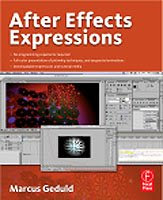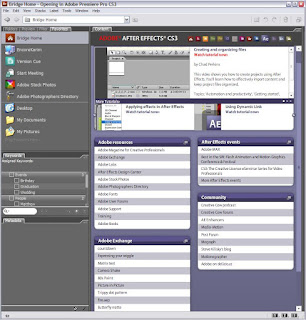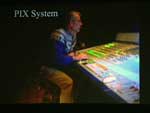Update: There's a new resource summary on PVC,
Using and creating After Effects scripts.
Expressions are scripts, but not in the AE world, where scripts are supposed to refer to AE scripts as in the article above. Unfortunately, this cobbled list isn't always clear; note that the leading lights are good resources for both.
.........................................................................................

Jeff Almasol is gradually updating his
redefinery scripts so they can be updated to work as
dockable panels in CS3. These will include the DV Rebel Tools and ones for Mark Christiansen’s
Studio Techniques book.
There's enough AE scripts and expressions floating around to make my head swim, and many of them have gestated at
AE Enhancers, the uberforum for scripts, expressions, and presets. Many script and expressions can be freely used, distribute or modified. Here's a quick summary of scripting resources mostly mentioned in AEP posts tagged
Pixel Bender,
Expressions or
Scripting...
Expressions & Scripting Resources for After Effects
Training and scripts can be found at:
 Motionscript
Motionscript by Dan Ebberts has both introductory and advanced stuff. It's a project-based resource for After Effects scripting and expressions (and there is a difference; for the user scripts are push button affairs). JJ Gifford's basic
Expressions in After Effects is old but still attractive.
The Help system is a good resource; see the online version,
Adobe AE LiveDocs, which has expressions help and
examples. Adobe is offering a scripting guide for AE 8/CS3 at the
Developer Center; see Todd Kopriva's
outline of changes. See also the AE Help pages on
Scripts and on
Expressions. You can ask direct questions at the
Adobe AE scripting forum.

Other expression training can be found in books like
Creating Motion Graphics With After Effects by Trish & Chris Meyer (Dan Ebberts likes the big bonus chapter on the DVD and contributes his own Scripting Overview chapter). They're also adding a 12-part series Deeper Modes of Expression on PVC, based on an extra in their book.
See also
The DV Rebel Guide, as well as in video training like
After Effects Pro: Professional Features by
Total Training.
Adobe After Effects Studio Techniques by
Mark Christiansen trumps these in the latest version of the book, which features a chapter written by Dan Ebberts.
Creative Cow has a wide variety of expressions tutorials, and
forum habited by Dan Ebberts.
These sites provide expressions and scripts but not so much training:
 Lloyd Alvarez
Lloyd Alvarez has an often-updated collection of scripts for AE, including BG Renderer CS3, at his domain
AE Scripts that later expanded to add top scripting authors and a shopping cart for downloads. Most scripts are still free but the cart makes tipping easier. See also
Lloyd Alvarez's AENY presentation on AE scripting. In 2009-2010, Lloyd had an ongoing course at
fxphd, an
Introduction to After Effects Scripting.
 redefinery
redefinery from Jeff Almasol has a great script library along 'AE Scripting' fundamentals. Jeff Almasol is gradually updating his scripts so they can be updated to work as dockable panels in AE CS3. These will include the DV Rebel Tools and ones for Mark Christiansen’s Studio Techniques book.
nabscripts from Charles Bordenave has a good number (English and French). He even has something to help
you translate scripts into your own language; this script supports English, French, German, Italian and Spanish.
Dr. Woohoo specializes in AE<-->Flash integration where Adobe leaves off.
More valuable scripts and expressions can be found at:
Creative Workflow Hacks who links to
Armored Squirrel, colinbraley.com,
crgreen.com,
Leapfrog Productions,
nabscripts,
Peter Torpey. Cool scripts by
Jeff Almasol are also in
The DV Rebel's Guide by Stu Maschwitz.
XScriptorium, a new AE scripting resource, was launched in August 2008, and has been testing a revised interface at
http://v2.xscriptorium.com. It's joined by a similar new website,
After Effects Expressions Reference or AEER. Both aim to help organize and present the vast array of available scripts and expressions.
But wait there's more:
Update: Create Digital Motion posted
Edit Ninja: Super Fast Video Sampling Workflow with After Effects Scripting. Here's a snippet: "Like to cut up and sample video? Sick of all that time-consuming scrubbing, slicing and rearranging in
Vegas or
Premiere? Well I’ve figured out a workflow using a collection of
After Effects scripts which turns lots of tedious editing into a very quick process to output a series of video clips for your VJing pleasure. This technique uses the following After Effects scripts:
AEScripts‘ “
Magnum - the Edit Detector”
Reverse Selected Layer Order
Precomp to Layer Duration
Redefinery’s
RenderLayers, and
ScriptLauncher, to speed things up even further."
Update: from the aether...
Jonas Hummelstrand noted scripts which provide "needed-every-day-functionality:"
--
Lloyd Alvarez scripts "
Zorro," "Throttler" and "BG Render"
--
Jeff Almosal scripts "KeyedUp," "ScriptsLauncher," "Statesman," and "CompositionSetter"
-- Dale Bradshaw’s & Paul Tuersley's
camera rigging script
-- Dale Bradshaw’s
Lower-thirds-generator
-- Paul Tuersley's
TrackerViz
 Update (December 2008)
Update (December 2008):
After Effects Expressions by Marcus Geduld is a new book on expressions in AE from
Focal Press. As noted by
Todd Kopriva, Focal Press have made a couple of excerpts of this book available for free. There's also a
review of the book by Steve Douglas on Ken Stone's FCP, and you can see the author in action on at least 2 training videos; check out videos
Making key frames loop in After Effects and
The "wiggle" expression in After Effects.
Update: Todd Kopriva is updating the scripting guide for CS4, and
posted a crib sheet with the new and changed items on his blog.
Update: Dr. WooHoo is involved with Flash panel and ExtendScript connections with AIR apps and CS4; see
New SwitchBoard and PatchPanel tutorials…
Info on Adobe image processing archtecture and new plug-in format in CS4 can be found in previous articles on
Pixel Bender, and at
Kevin Goldsmith's blog.
Update: In
Programmatic Animations in AE with Expressions & Scripting, Michael Coleman and Dan Ebberts (
fullscreen) show tips and tricks with Scripting and Expressions in CS4. The parts on the video metadata pipeline were covered more full by Dan Ebberts in an article posted in early 2009 at Adobe,
XMP metadata in Creative Suite 4 Production Premium.
Update:
Sébastien Périer (Sebastien Perier for Google) has compiled a
Top 10 list of After Effects workflow enhancing scripts, ones that he uses the most on a project basis. He also notes AE scripts and websites like
AEER, or
After Effects Expressions Reference and
Final Cut 2 After Effects.
Update:
AExtensions is a blog by
Mathias Möhl (Mohl for Google), the mind behind the Tracker2Mask, KeyTweak, (
AEP backgrounder post) and MochaImport scripts. He doesn't post frequently but posts present deep new features and include video tutorials.
Update: Satya Meka posted the tutorial
Intro to Pixel Bender for Non-Programmers, and he likes the math explanations at
BetterExplained.
Update: AEtuts started a video series by Frederik Steinmetz,
Introduction To Writing Scripts For AE.
Update:
Le freelance saucisse is an AE expressions resource in French with interesting and challenging examples. Google Chrome will translate it automatically for your convenience.
FeltTips returned with a few tutorials on expressions, After Effects Random Expression Shenanigans and Quick After Effects Expressions #1 - Camera Targetter.
Lester Banks unearthed a 16-tutorial series on expressions by Arun Latvia on YouTube.
AE Scripts and Mamoworld now offer ExpressionTimeline, a new After Effects script that lets you combine and modify expressions without editing the code itself.
iExpressions
from Mamoworld combines the power of After Effects expressions with the
convenience of effect plug-ins. They allow you to use expressions
without writing any code -- each iExpression comes with an interface to
control everything using adjustable parameters. iExpressions seems like
something out of
Stu Mashwitz blog on the potential of a nodes property panel, but it's just script UI for each expression. iExpressions, available on
AE Scripts, ships with over 60 iExpressions in six different categories:
Audio,
Linking,
Movement Modifier,
Physics Simulations,
Source Text, and
Wiggles (links to demo movies).










 redefinery
redefinery



























